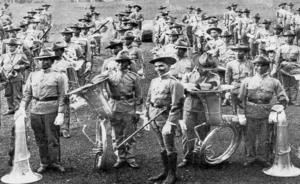Philippine Constabulary Band
| Philippine Constabulary Band | |
|---|---|
|
The Philippine Constabulary Band pictured at the Louisiana Purchase Exposition in 1904. | |
| Active | 1901–1942 |
| Country |
|
| Allegiance |
|
| Branch | Philippine Constabulary |
| Type | Military band |
| Role | Public duties |
| Size | 85 personnel (1909),[1] 100 personnel (1937)[2] |
| Nickname(s) | "Taft's Own" |
| Patron | William Howard Taft |
| Commanders | |
| Notable commanders | Walter Loving |
The Philippine Constabulary Band was the principal military band of the Philippine Constabulary, and later, as the Philippine Army Orchestra, of the Army of the Commonwealth of the Philippines. Between its establishment in 1901 and dissolution during World War II, it registered a reputation for musical excellence both in the Philippines and the United States, and is credited with being the first band other than the United States Marine Band to provide the musical escort to the President of the United States during a U.S. presidential inauguration. The Philippine Army Band considers itself the successor to the Philippine Constabulary Band.
History
Formation and early years
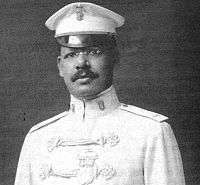
The Philippine Constabulary Band was formed on the orders of Colonel Henry Allen, the first chief of the Philippine Constabulary.[2] Walter Loving, a former United States Army regimental band leader who had been educated at the New England Conservatory of Music, successfully applied for the directorship of the new organization which saw its first public performance in late 1902 at the Manila Elks Club.[2] The band's first members were recruited by Loving from community ensembles that performed in the small towns of Luzon, some of whom were former musicians in Spanish Army bands.[2][3] Auditions for the ensemble were fierce; 300 clarinetists, for instance, tried out for just eight billets.[2]
As the constabulary's only band, it was a fixture of ceremonial and social engagements at Malacañang Palace where it met with the appreciation of Governor-General of the Philippines William Howard Taft.[4] Taft responded favorably to virtually all of Loving's appropriations requests for the band; his support of the group led to the unofficial moniker "Taft's Own."[2]
St. Louis World's Fair
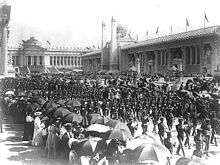
The band's first overseas performance came just three years after its formation when it accompanied the Philippine Scouts to the Louisiana Purchase Exposition of 1904 in St. Louis, Missouri. Four companies of Scouts had been sent to the fair to drill the manual of arms for President Theodore Roosevelt, who requested that the Constabulary Band play one of his favorite marches, The Garryowen, which it obliged as the president "clapped heartily."[5] John Philip Sousa, who was in attendance at the fair, was among those who heard the Philippine Constabulary Band play and remarked, "I am simply amazed. I have rarely heard such playing."[6]
1909 U.S. presidential inauguration
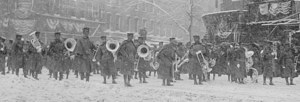
The Philippine Constabulary Band was the lead unit in the United States presidential inaugural parade of 1909, which saw its former patron William Howard Taft inaugurated as president of the United States. It was the first time a band other than the United States Marine Band served as the musical escort to the President of the United States. (The Band of the Philippine Scouts appeared at the 1905 inaugural of Theodore Roosevelt, but did not lead the procession.)[7][8] The 1909 inaugural parade occurred in a record-setting snowstorm, and was the first time most of the bandsmen had seen snow. Afterwards, The New York Times wrote of the band's appearance:[1]

President Taft to them is still 'the big Governor,' and as an officer who is traveling with the organization expressed it last night, "the President is the only man on earth these little fellows would have tramped through that blizzard for." After their hard day's work as the musical escort for President Taft, the medical officers who have them in charge were apprehensive less some of them might develop pneumonia or other pulmonary trouble from exposure to weather so foreign to their native land.
The day after the inauguration the band was invited to perform for the president and Mrs. Taft at the White House, becoming the first band in history from outside the continental United States to perform at a White House reception.[9] (It is also believed this may have been the first time an African-American conducted a musical performance at the White House, Loving being African-American.)[9]
After its inaugural engagement, the band remained in the mainland United States for several months, performing at other public events. A concert at the New York Hippodrome met with a "rousing reception" in which "encore after encore" was demanded, the band finally concluding with the overture from Tannhäuser followed by the Stars and Stripes Forever.[1] On April 17, 1909, the band returned to Washington at the request of Helen Taft to perform at the opening of West Potomac Park.[10] Later, it appeared in Seattle at the Alaska-Yukon-Pacific Exposition to herald the arrival of President Taft for his inspection of the fairgrounds. The band then traveled to San Francisco, California to depart for the return voyage to the Philippines. As their troopship was departing, Taft ordered his own vessel to pull alongside. Seeing the president's ship approach, the band struck up Hail to the Chief prompting Taft to shout back "goodbye, boys – I wish you a pleasant voyage!"[11]
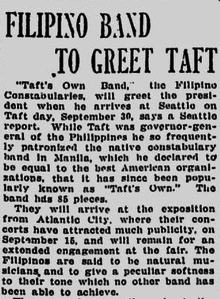
Panama Pacific International Exposition
The band's third major overseas performance came in 1915 when it was engaged to appear at the Panama Pacific International Exposition in San Francisco. Its reputation by then well-secured in the United States, the band remained stationed in California for nearly a year, during which time it performed 115 public concerts.[12] During this time it again met John Philip Sousa, who on one occasion guest conducted the band and afterwards commented, "when I closed my eyes, I thought it was the United States Marine Band."[9]
Changing directors
In 1915 Walter Loving sought, and was granted, a medical disability due to worsening tuberculosis. He was replaced as director of the band by Pedro B. Navarro. Navarro had been with the PC Band since 1902, served as Loving's assistant conductor since 1904, and took over when Loving fell ill during the 1915 Panama Pacific International Exposition.[13] He was succeeded by José Silos in 1918. During this period the quality of the band suffered and, in 1920, Loving returned to the Philippines to rebuild the group. As part of his long-term plan to ensure the future stability of the band, he hand-picked bandsman Alfonso Fresnido to succeed him. Fresnido was sent to Ohio to study conducting at the Dana Music Institute (now the Dana School of Music at Youngstown State University) before returning to take over the band from Loving, who retired a second time in 1923.[2]
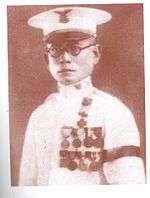
Reorganization as Philippine Army Orchestra
With the establishment of the Commonwealth of the Philippines in 1935, the Constabulary Band was officially renamed the Philippine Army Orchestra and redesignated a Philippine Army unit. (After the Constabulary was reestablished, the band was not reassigned to it). Alfonso Fresnido continued as the band's director through 1937. That year, Walter Loving accepted an invitation from President Manuel L. Quezon to again take up direction of the unit at the rank of lieutnant-colonel in the Philippine Commonwealth Army and joint appointment as "Special Adviser to the President of the Philippines". The band premiered the Collectivista March, a tribute march composed by Loving and dedicated to President Quezon, at Luneta Park later that year.[2]
In 1939, the Philippine government sent the band to represent the commonwealth at the Golden Gate International Exposition in San Francisco.[14] Loving retired for the third time the following year; he remained in Manila and would occasionally take up the baton as guest conductor.[2]
Dissolution and legacy
The band ceased to exist following the Japanese occupation of the Philippines in 1942.[2] During the course of hostilities, most of its members were killed.[15]
After the war, which neither Loving nor Fresnido survived, the Philippine Army organized a new group, the "Philippine Army Band", as its premier musical ensemble under the direction of Lieutenant (later, Colonel) Antonino Buenaventura.[16][17]
The modern Philippine Army Band considers itself the successor to the Philippine Constabulary Band. According to it, "the PA Band is the fulfilment of the first American civil governor William Howard Taft’s promise of forming a Filipino military band that would be a counterpart of the famous US Marine Band."[3]
List of commanders
| Name | Dates of command |
|---|---|
| Walter Loving | 1902 to 1915 |
| Pedro Navarro | 1915 to 1917 |
| José Silos | 1917 to 1920 |
| Walter Loving | 1920 to 1923 |
| Alfonso Fresnido | 1923 to 1937 |
| Walter Loving | 1937 to 1940 |
| Alfonso Fresnido | 1940 to 1941 |
Reputation and reception
The U.S. military periodical Army and Navy Life described the band as "one of the finest of all military bands in the world", and the Pacific Coast Musical Review considered the band "in a class by itself."[9][18][19]
See also
References
- 1 2 3 "Hearty Cheers for Philippine Band". The New York Times. 8 March 1909. Retrieved 9 September 2015.
- 1 2 3 4 5 6 7 8 9 10 Yoder, Robert (2013). In Performance: Walter Howard Loving and the Philippine Constabulary Band. National Historic Commission of the Philippines. ISBN 9715382592.
- 1 2 "When Army goes 'do, re, mi'". army.mil.ph. Philippine Army. Retrieved 10 September 2015.
- ↑ "The Philippine Constabulary Band". himig.com.ph. Ayala Foundation. Retrieved 9 September 2015.
- ↑ Westfall, Matthew (2012). The Devil's Causeway. Globe Pequot. ISBN 9780762787463.
- ↑ Brownell, Susan (2008). The 1904 Anthropology Days and Olympic Games. University of Nebraska Press. p. 203. ISBN 0803210981.
- ↑ Handy, Antoinette (1999). Black Women in American Bands and Orchestras. Scarecrow. p. 19. ISBN 0810834197.
- ↑ Hila, Antonio (11 March 2013). "Believe it or not, a Philippine band had taken part in a US presidential inaugural". Philippine Daily Inquirer. Retrieved 9 September 2015.
- 1 2 3 4 Johnson, Michael. "Reports of Research in Music Education Presented at the Annual Meeting of the Texas Music Educators Association San Antonio, Texas, February, 2004" (PDF). tmea.org. Texas Music Educators Association. Retrieved 9 September 2015.
- ↑ "First Lady Helen Taft's Luneta". whitehousehistory.org. White House Historical Association. Retrieved 9 September 2015.
- ↑ Cunningham, Roger (Summer 2007). "The Loving Touch" (PDF). Army History. Retrieved 9 September 2015.
- ↑ Miller, Leta (2011). Music and Politics in San Francisco: From the 1906 Quake to the Second World War. University of California Press. p. 249. ISBN 0520268911.
- ↑ Talusan, Mary. 2013. “Music, Race, and Imperialism: The Philippine Constabulary Band at the 1904 St. Louis World’s Fair," Chapter 5 in Mixed Blessing: The Impact of the American Colonial Experience on Politics and Society in the Philippines edited by Hazel M. McFerson. Westport, CT: Greenwood Publishing Group.
- ↑ Alcazaren, Paoulo (4 December 2010). "Loving's band". Philippine Star. Retrieved 9 September 2015.
- ↑ "PHILIPPINE MUSIC: Artist and Organization". CCP Encyclopedia of Philippine Art. Retrieved 3 October 2015.
- ↑ "Col. Antonino Buenaventura". himig.com.ph. Ayala Foundation. Retrieved 3 October 2015.
- ↑ "2014 CCP ORCHESTRA AND BA ND FESTIVAL : PART I CIPANTS" (PDF). culturalcenter.gov.ph. Government of the Philippines. Retrieved 3 October 2015.
- ↑ Walker, David (20 March 1915). "Philippine Constabulary Band Concert". Pacific Coast Musical Review. Retrieved 9 September 2015.
- ↑ Army and Navy Life, vol. 14. 1909. p. 286. Retrieved 9 September 2015.
